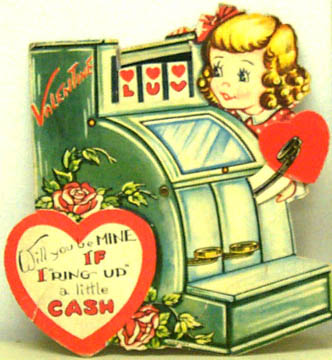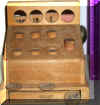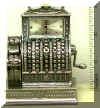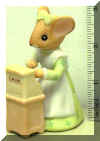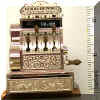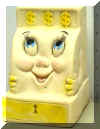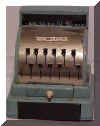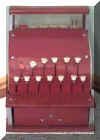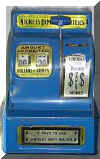| ... |
|||||||||||||
 |
|||||||||||||
| Shop Toys | Auctions | Magazine | Chat-Forum | About Us | |||||||||
|
|
||
How I Caught "Collector's Fever" for Toy Cash Registers |
||
By Cybele Elaine Werts In the spring of 1984 I moved from Philadelphia to San Diego where I discovered a beautiful battery-operated toy cash register that looked exactly like one I’d had as a child. I bought it for $10 and set it on my windowsill to admire. Twenty years later I have over 100 toy cash registers and love every one. This is the story of how one little toy turned into a passion for collecting. The Early Days For the first few years my toy cash registers functioned simply as a decorative element for my windowsill. They had not yet achieved the status of being a "collection." At a certain point I realized that I had something worth displaying, and I started cataloging and displaying them. The first home computer, the Apple computer, had just come on the market and none of us knew how to use it yet, so instead I created color-coded catalogue sheets and dutifully recorded the make, model, and measurements of each toy. During this time there weren’t that many items available, so my standards were very low. In other words, I bought anything that I found. A Change to a World Market Things went along this way until 1999 when I discovered eBay. Prior to the internet, collecting was limited by geography in that I could either buy new toy cash registers at toy stores or old ones at antique shops; a costly proposition. eBay created a world market, so that items like the 1970’s Tom Thumb metal cash registers which previously sold for $60+, now are worth $5 or less. They became essentially worthless because of this shift to an international market. The resulting loss in value is the downside of this revolution. The upside is that I can now buy items that are both unusual and relatively inexpensive. I’m very lucky that I collect something that possibly no one else does (to my knowledge) which means that I can get far better deals than if there was a huge competition like there is for popular collectables like dolls and teddy bears. I rarely play more than $35 for an item, and quite often significantly less. How this Change Affected my Collection, and Collecting in General This change in how toys were bought and sold affected my collection in a major way. Once I realized that the majority of my collection had little worth, I created a more focused mission statement which centered on collecting only character-based registers like Disney and Sesame Street, musical cash registers, one of a kinds, and miniatures. I changed my mindset from an approach of buying anything I could get my hands on, to only buying items that made my heart go pitter patter. Around 2002 I found that my livingroom had become overrun with toys, so I donated about 150 registers from my collection to a local good works group. This donation included contemporary toys that had no distinguishing features, older registers like the ubiquitous Tom Thumbs, and antique items that I just plain didn’t like. I didn’t want anything taking up space in my home unless it had some unique design factor. I can just imagine what they were thinking when they opened up all those boxes! Buying Strategies The best buys I’ve found have been ones where the seller was unaware of the value of the item, and started with a very low bid. If I was really lucky, they offered a low "Buy It Now" price which I was able to snap up. The key thing here is to check the listings every day so that you can catch items as soon as they are put up for bidding. If you are working on a budget, as most of us are, don’t waste your money buying items that are just "nice." Wait for the truly special items and bid more for them. If you are using eBay, learn to use the advanced search mechanism so that you don’t have to browse through tons of irrelevant items. For example, if you simply search of "cash register" you will find thousands of them, most of which are actual cash register, not toys. But also be careful not to look in too narrow a category area such as "mechanical banks" because many interesting items are either misfiled in other categories, or things you might not have thought of. A good example of this is the tape measure cash register, which is not considered a toy. In the beginning it can be difficult to know what is a truly unique item, and what is not. That’s why educating yourself is the single most important factor in getting good deals. Sellers often call their items "antique" and "rare" even if they aren’t. My approach now is to bid a medium low amount, then check in near to closing. I place a large bid on the item a few hours before it closes so that the other buyers are less likely to respond to the outbid notices before the item closes. Why Toy Cash Registers? There are several reasons why toy cash registers really speak to me. A lot of people think that it’s because I’m a shopaholic or money hungry, but it’s not that at all. I’ve always enjoyed toys even though I’ve never particularly enjoyed children. I love the bright colors and the amazing number of creative ways that toymakers come up with unique and wonderful products. The bottom line is that there’s something intangibly wonderful about toy cash registers that I still feel after twenty years of collecting. How I Define a Toy Cash Register Toy cash registers have some similar features with both typewriters and with slot machines so things can get muddy sometimes. I decided early on that I needed to be careful about what I collected so as not to dilute my collection with items that didn’t fit my mission. There is no one descriptor that you can use for every toy in my collection, rather I define a toy cash register as a toy that has the "spirit" of a cash register. This usually includes one or more of these type of character traits: buttons you can push, pop up tabs with the prices, a cash drawer, and a hand crank. When there’s doubt in my mind, I look at whether the item has a preponderance of these descriptors. What is a Well-Designed Toy Cash Register? I believe that an interesting collection, whether toy cash registers or matchbooks, should have a focus. I focused my collection primarily for space reasons, but any collection will be far more interesting if there is a theme. As with all collectibles you’ll look for condition, rarity, and age. What I look for specifically with toy cash registers is for creativity and unique characteristics, as well as detailing. This is the reason that I don’t collect a number of well-known toy cash registers including the Uncle Sam and Tom Thumb lines. The reason is that I don’t find these designs at all creative or pleasurable to look at. If you look at my favorites (see sidebar at right) you’ll notice that each one is truly unique in some way, fun to look at, and brings you back again to look again. Items I do NOT collect One of the most common questions I hear is "why don’t you collect real cash registers?" The answer to that is because they are big, heavy, and expensive. Besides, toys are much more fun! I also do not collect items that are not unique in any way, pictures or other collateral materials (with a few notable exceptions), or accoutrements such as lights, advertising toppers, coin dishes, drawers, keys and so on. Toys and Technology I am fascinated by how toys reflect technological progress. For example the oldest toys reflect the mechanical, rounded front cash registers of the early 1900’s. Here’s an example:
When actual cash registers became electric, that design style was reflected in the toys which changed to a "flat" front style and were mostly plastic. Hereís a nice wooden example:
As scanning registers became popularized, you see toys with bar code scanners, both the "gun" type and the "pass over" type. The Hello Kitty register is unique in that it actually scans bar codes and shows the total in the electronic window. Here is an example:
Most recently, the toys have credit card slots, some of which make sounds or actually make that modem connecting electronic crackle as they "approve" your purchase. Here's an example:†
© Cybele Elaine Werts |
||
My Favorite Toy Cash Registers |
||
|
||
|
||
|
||
|
||
|
||
|
||
|
||
|
||
|
||
|
||
|
||
|
||
| Not
So Favorite Toy Cash Registers In contrast, here are some examples of what I consider really boring examples of toy cash registers. The colors are uninspired, there is little artistic or creative merit, and even the shape is common. |
||
|
||
|
||
|
||
|
||
| top of page | Toyzine Home | Toys For Sale | Toyzine Mall | Online Magazine | Wanted Classifieds | Global Directory | About Toyzine |
|
|
|
|
Copyright 1997-2024 Toyzine.Com All Rights Reserved. Designated trademarks and brands are the property of their respective owners. Use of this Website constitutes acceptance of the Toyzine.Com User Agreement, Privacy Policy and Terms of Use. All or any of the material on this Website may not be published, broadcast, rewritten or redistributed in any form without the prior written permission of Toyzine.Com
|
|||


